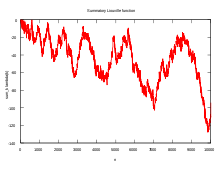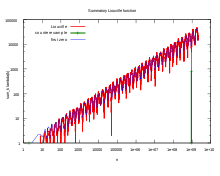Liouville function
The Liouville function, denoted by λ(n) and named after Joseph Liouville, is an important function in number theory.
If n is a positive integer, then λ(n) is defined as:
where Ω(n) is the number of prime factors of n, counted with multiplicity (sequence A008836 in the OEIS).
λ is completely multiplicative since Ω(n) is completely additive, i.e.: Ω(ab) = Ω(a) + Ω(b). The number 1 has no prime factors, so Ω(1) = 0 and therefore λ(1) = 1. The Liouville function satisfies the identity:
The Liouville function's Dirichlet inverse is the absolute value of the Möbius function.
Series
The Dirichlet series for the Liouville function is related to the Riemann zeta function by
The Lambert series for the Liouville function is
where is the Jacobi theta function.
Conjectures




The Pólya conjecture is a conjecture made by George Pólya in 1919. Defining
the conjecture states that for n > 1. This turned out to be false. The smallest counter-example is n = 906150257, found by Minoru Tanaka in 1980. It has since been shown that L(n) > 0.0618672√n for infinitely many positive integers n,[1] while it can also be shown via the same methods that L(n) < -1.3892783√n for infinitely many positive integers n.[2]
Define the related sum
It was open for some time whether T(n) ≥ 0 for sufficiently big n ≥ n0 (this conjecture is occasionally–though incorrectly–attributed to Pál Turán). This was then disproved by Haselgrove (1958), who showed that T(n) takes negative values infinitely often. A confirmation of this positivity conjecture would have led to a proof of the Riemann hypothesis, as was shown by Pál Turán.
References
- ↑ P. Borwein, R. Ferguson, and M. J. Mossinghoff, Sign Changes in Sums of the Liouville Function, Mathematics of Computation 77 (2008), no. 263, 1681–1694.
- ↑ Peter Humphries, The distribution of weighted sums of the Liouville function and Pólya’s conjecture, Journal of Number Theory 133 (2013), 545–582.
- Polya, G. (1919). "Verschiedene Bemerkungen zur Zahlentheorie". Jahresbericht der Deutschen Mathematiker-Vereinigung. 28: 31–40.
- Haselgrove, C. Brian (1958). "A disproof of a conjecture of Polya". Mathematika. 5 (2): 141–145. ISSN 0025-5793. MR 0104638. Zbl 0085.27102. doi:10.1112/S0025579300001480.
- Lehman, R. (1960). "On Liouville's function". Math. Comp. 14: 311–320. MR 0120198. doi:10.1090/S0025-5718-1960-0120198-5.
- Tanaka, Minoru (1980). "A Numerical Investigation on Cumulative Sum of the Liouville Function". Tokyo Journal of Mathematics. 3 (1): 187–189. MR 0584557. doi:10.3836/tjm/1270216093.
- Weisstein, Eric W. "Liouville Function". MathWorld.
- A.F. Lavrik (2001) [1994], "Liouville function", in Hazewinkel, Michiel, Encyclopedia of Mathematics, Springer Science+Business Media B.V. / Kluwer Academic Publishers, ISBN 978-1-55608-010-4